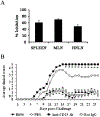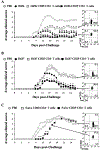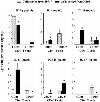Regulatory T cell vaccination without autoantigen protects against experimental autoimmune encephalomyelitis
- PMID: 17237429
- PMCID: PMC9811398
- DOI: 10.4049/jimmunol.178.3.1791
Regulatory T cell vaccination without autoantigen protects against experimental autoimmune encephalomyelitis
Abstract
Regulatory T (T(reg)) cells show promise for treating autoimmune diseases, but their induction to elevated potency has been problematic when the most optimally derived cells are from diseased animals. To circumvent reliance on autoantigen-reactive T(reg) cells, stimulation to myelin-independent Ags may offer a viable alternative while maintaining potency to treat experimental autoimmune encephalomyelitis (EAE). The experimental Salmonella vaccine expressing colonization factor Ag I possesses anti-inflammatory properties and, when applied therapeutically, reduces further development of EAE in SJL mice. To ascertain T(reg) cell dependency, a kinetic analysis was performed showing increased levels of FoxP3(+)CD25(+)CD4(+) T cells. Inactivation of these T(reg) cells resulted in loss of protection. Adoptive transfer of the vaccine-induced T(reg) cells protected mice against EAE with greater potency than naive or Salmonella vector-induced T(reg) cells, and cytokine analysis revealed enhanced production of TGF-beta, not IL-10. The development of these T(reg) cells in conjunction with immune deviation by Th2 cells optimally induced protective T(reg) cells when compared those induced in the absence of Th2 cells. These data show that T(reg) cells can be induced to high potency to non-disease-inducing Ags using a bacterial vaccine.
Conflict of interest statement
Disclosures
The authors have no financial conflict of interest.
Figures






Similar articles
-
IL-13 production by regulatory T cells protects against experimental autoimmune encephalomyelitis independently of autoantigen.J Immunol. 2008 Jul 15;181(2):954-68. doi: 10.4049/jimmunol.181.2.954. J Immunol. 2008. PMID: 18606647 Free PMC article.
-
Vaccination without autoantigen protects against collagen II-induced arthritis via immune deviation and regulatory T cells.J Immunol. 2008 Aug 15;181(4):2741-52. doi: 10.4049/jimmunol.181.4.2741. J Immunol. 2008. PMID: 18684965 Free PMC article.
-
Tolerance in the absence of autoantigen.Endocr Metab Immune Disord Drug Targets. 2007 Sep;7(3):203-10. doi: 10.2174/187153007781662549. Endocr Metab Immune Disord Drug Targets. 2007. PMID: 17897047 Free PMC article. Review.
-
Bystander-mediated stimulation of proteolipid protein-specific regulatory T (Treg) cells confers protection against experimental autoimmune encephalomyelitis (EAE) via TGF-β.J Neuroimmunol. 2012 Apr;245(1-2):39-47. doi: 10.1016/j.jneuroim.2012.02.003. Epub 2012 Mar 13. J Neuroimmunol. 2012. PMID: 22418032 Free PMC article.
-
Regulation of experimental autoimmune encephalomyelitis (EAE) by CD4+CD25+ regulatory T cells.Novartis Found Symp. 2003;252:45-52; discussion 52-4, 106-14. Novartis Found Symp. 2003. PMID: 14609211 Review.
Cited by
-
IL-13 production by regulatory T cells protects against experimental autoimmune encephalomyelitis independently of autoantigen.J Immunol. 2008 Jul 15;181(2):954-68. doi: 10.4049/jimmunol.181.2.954. J Immunol. 2008. PMID: 18606647 Free PMC article.
-
An IL-12 DNA vaccine co-expressing Yersinia pestis antigens protects against pneumonic plague.Vaccine. 2009 Jan 1;27(1):80-7. doi: 10.1016/j.vaccine.2008.10.021. Epub 2008 Oct 26. Vaccine. 2009. PMID: 18955097 Free PMC article.
-
Regulatory T-cell vaccination independent of auto-antigen.Exp Mol Med. 2014 Mar 14;46(3):e82. doi: 10.1038/emm.2014.4. Exp Mol Med. 2014. PMID: 24626168 Free PMC article. Review.
-
Vaccination without autoantigen protects against collagen II-induced arthritis via immune deviation and regulatory T cells.J Immunol. 2008 Aug 15;181(4):2741-52. doi: 10.4049/jimmunol.181.4.2741. J Immunol. 2008. PMID: 18684965 Free PMC article.
-
Immunological and Clinical Effect of Diet Modulation of the Gut Microbiome in Multiple Sclerosis Patients: A Pilot Study.Front Immunol. 2017 Oct 25;8:1391. doi: 10.3389/fimmu.2017.01391. eCollection 2017. Front Immunol. 2017. PMID: 29118761 Free PMC article.
References
-
- Sospedra M, and Martin R. 2005. Immunology of multiple sclerosis. Annu. Rev. Immunol 23: 683–747. - PubMed
-
- Steinman L 1996. Multiple sclerosis: a coordinated immunological attack against myelin in the central nervous system. Cell 85: 299–302. - PubMed
-
- Zeine R, Heath D, and Owens T. 1993. Enhanced response to antigen within lymph nodes of SJL/J mice that were protected against experimental allergic encephalomyelitis by T cell vaccination. J. Neuroimmunol 44: 85–94. - PubMed
-
- Shaw MK, Kim C, Hao HW, Chen F, and Tse HY. 1996. Induction of myelin basic protein-specific experimental autoimmune encephalomyelitis in C57BL/6 mice: mapping of T cell epitopes and T cell receptor Vβ gene segment usage. J. Neurosci. Res 45: 690–699. - PubMed
-
- Greer JM, Sobel RA, Sette A, Southwood S, Lees MB, and Kuchroo VK. 1996. Immunogenic and encephalitogenic epitope clusters of myelin proteolipid protein. J. Immunol 156: 371–379. - PubMed
Publication types
MeSH terms
Substances
Grants and funding
LinkOut - more resources
Full Text Sources
Other Literature Sources
Medical
Research Materials

